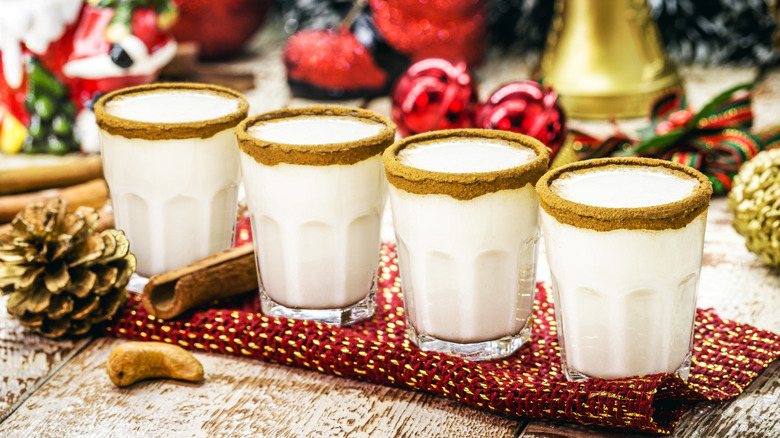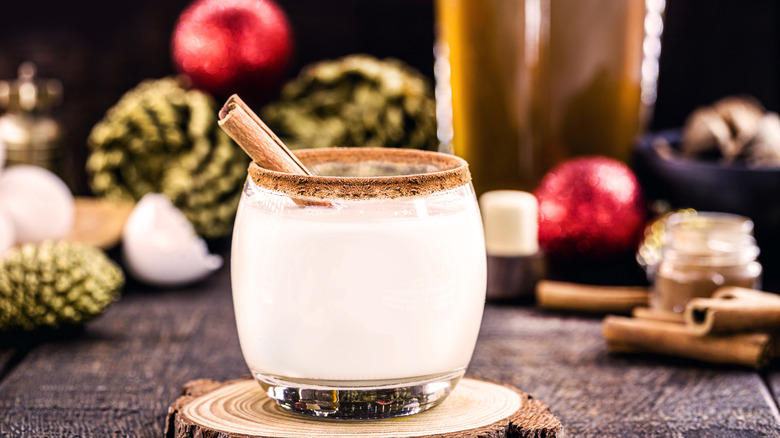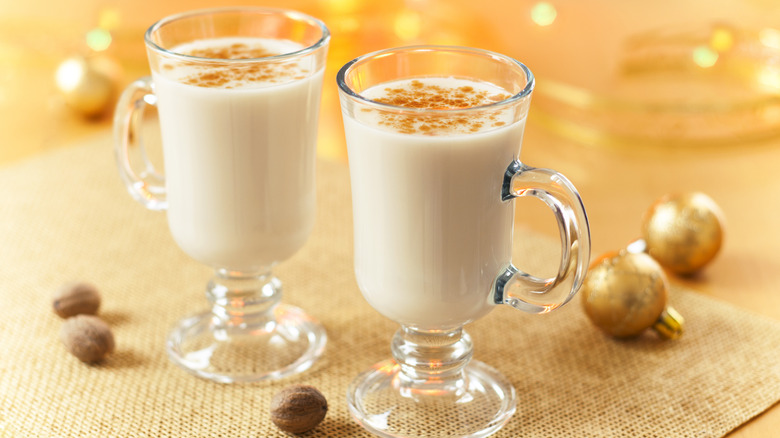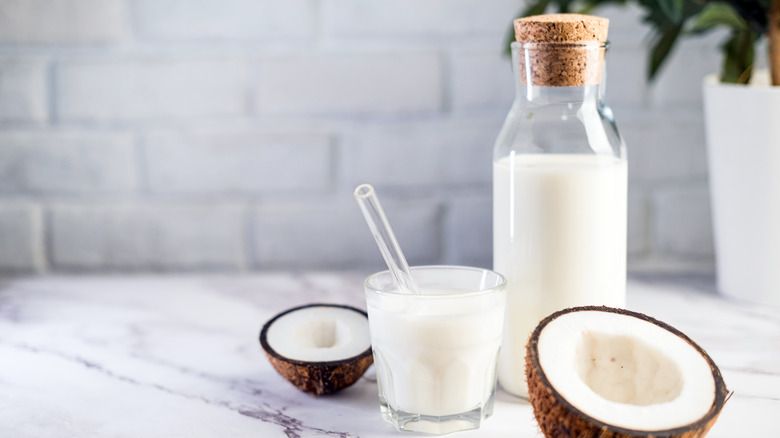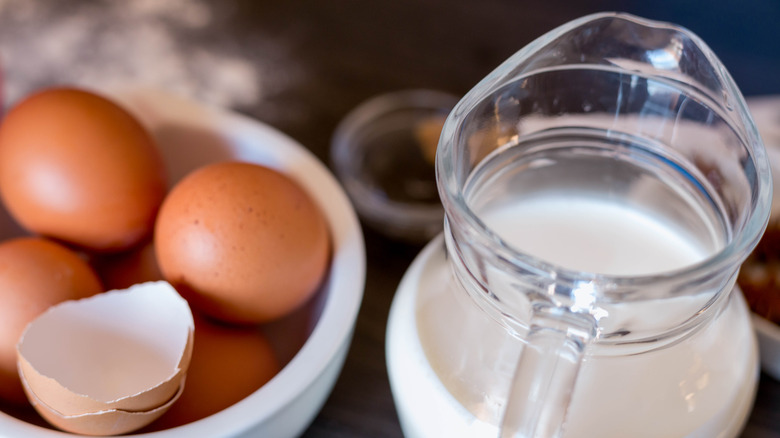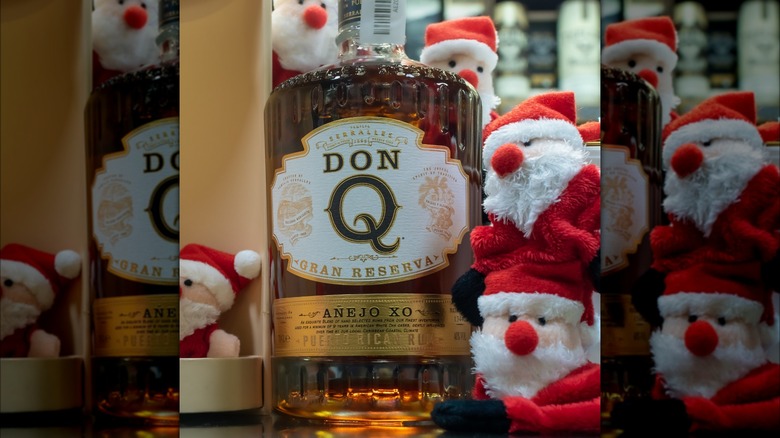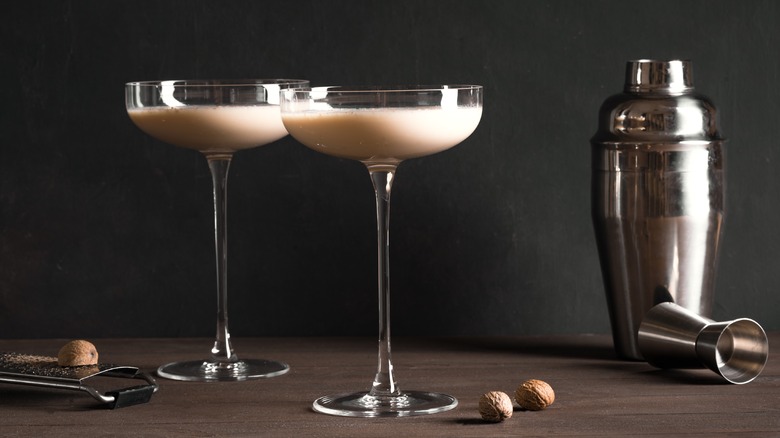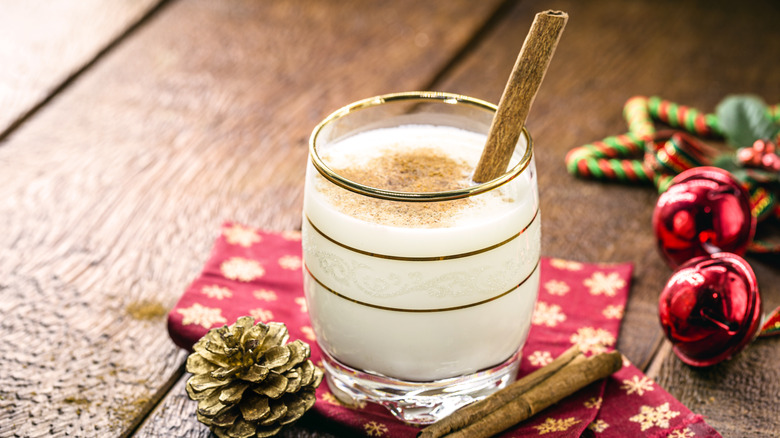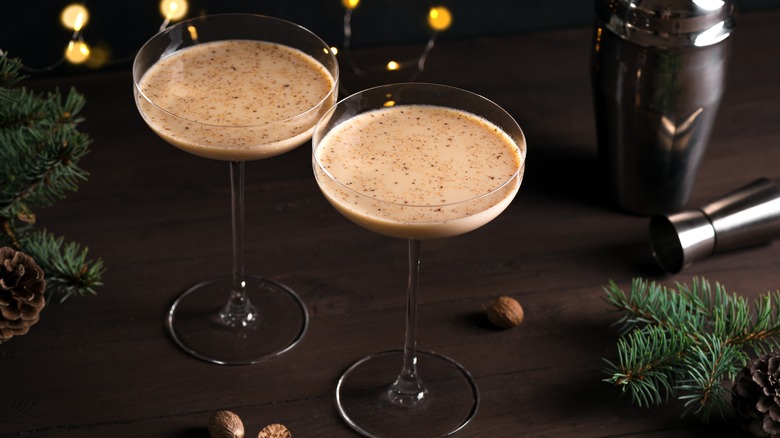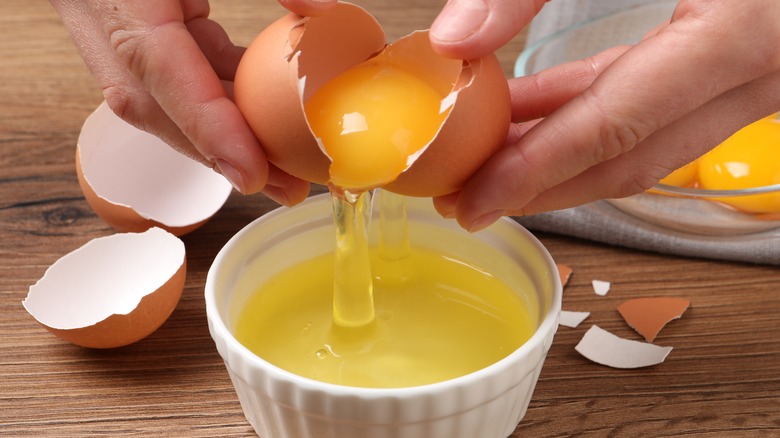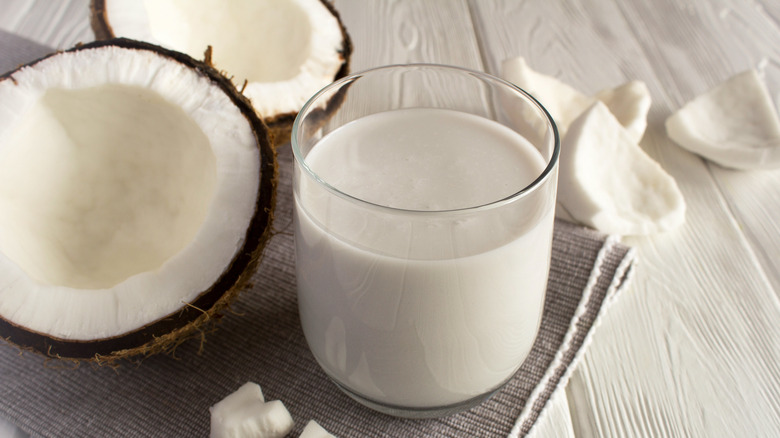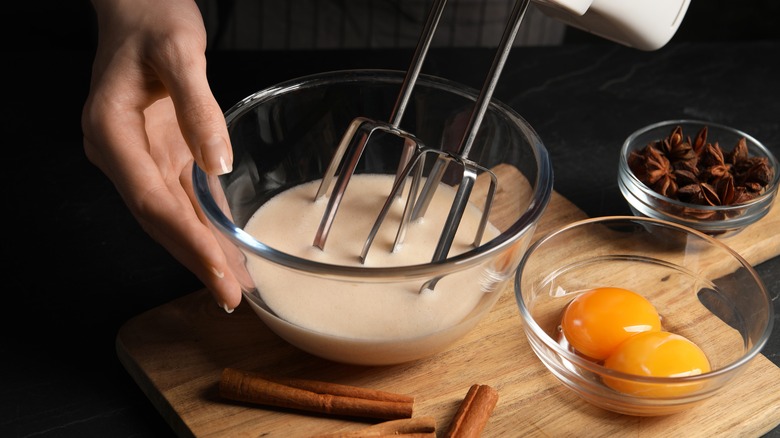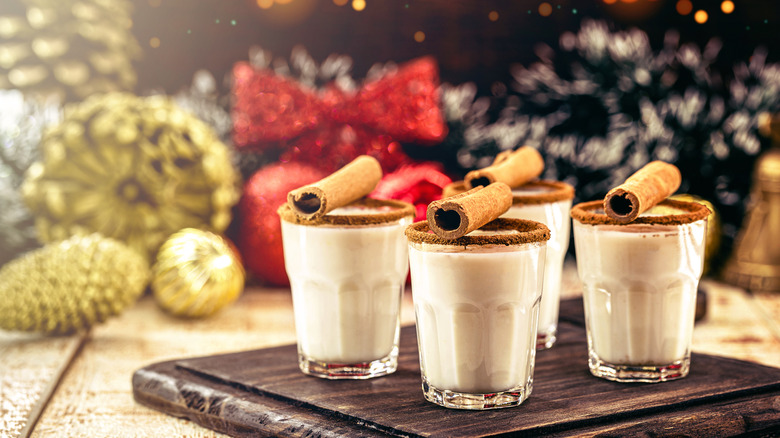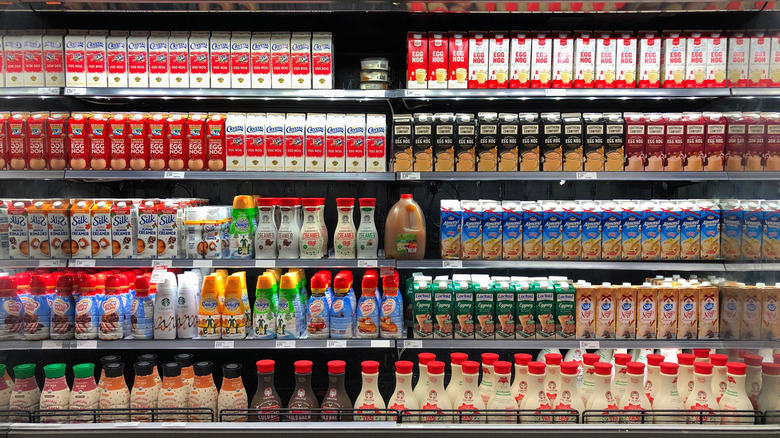Coquito Vs Eggnog: Everything You Need To Know About The Festive Holiday Drinks
During the holidays, there are countless drinks to make festive gatherings merrier. You might be looking for a smooth, classy cocktail like a Christmas Old Fashioned, or something family-friendly like Gingerbread Hot Chocolate. Maybe you're interested in trying one of the many festive drinks from around the world, like spicy, ruby-hued sorrel punch from Jamaica or boozy, coffee-infused cola de mono from Chile.
Sometimes, the holidays call for nothing but classic comforts, and it doesn't get more cozy and familiar than a cup of eggnog. The creamy, nutmeg-scented holiday treat is so thick that you practically have to eat it with a spoon, but its no-holds-barred decadence is what makes it one of the most ubiquitous indulgences of the season. If you're in Puerto Rico, however, you are just as likely to find coquito as the festive beverage of choice at holiday parties. This coconut-based, rum-infused drink is an inescapable part of the holidays there and is often incorrectly called "Puerto Rican eggnog" by outsiders. Both eggnog and coquito have a thick, creamy texture and warming spices, and both feature alcohol (though eggnog is commonly found without it). Despite these similarities, there are key differences to these festive libations, including flavor, preparation, history, and ingredients. Keep reading to discover what makes these two irresistible winter staples distinct, and why you might want to have both on hand this holiday season.
Coquito is a traditional Puerto Rican holiday drink
Meaning "little coconut" in Spanish, coquito is a beloved drink during the festive season in Puerto Rico and the Caribbean. It even has its own holiday on December 21st. Historians disagree about its precise origins. Although it is, without question, a product of Puerto Rico and does not traditionally have eggs, milk, or cream, it may be an offshoot of eggnog. Some believe that it sprang up during Spain's colonial rule in the region as a riff on the milky, eggy European drink that was known as ponche to the Spaniards at the time. This would explain why so many Central American and Caribbean countries that came under Spanish rule have similar holiday drinks, from Mexico's rompope to Trinidad and Venezuela's ponche crema and Cuba's crema de vie.
Another theory suggests that it was only invented in the early 20th century after Americans brought eggnog to the island. Regardless of which version is accurate, it wasn't until the mid-20th century that recipes for coquito appeared in cookbooks. These days, coquito is Puerto Rican, through and through. Made with cream of coconut and rum, it bears only a passing resemblance to the European or American versions of eggnog.
Eggnog originates from medieval Europe
The history of eggnog is even murkier than the history of coquito. The prevailing theory is that it evolved from a drink served in the wealthiest circles of medieval England called posset. The original recipe contained a stomach-churning combination of sweetened hot milk that was curdled in ale or wine, though the alcohol of choice became sherry. Monks are likely to blame (or thank) for the addition of raw eggs, though their inclusion of figs didn't catch on. Curdled milk and raw eggs in beer probably wouldn't bring much merriment to holiday celebrations these days, but in medieval times, the combination was the exclusive purview of the wealthy due to the expense of eggs and fresh milk.
North America is where the craze for the beverage took off, and possibly where the name "eggnog" arose. An early use of the word can be found in a travel log by Isaac Weld published in 1800. The egg part is obvious, and "nog" may have been a reference to "noggin," a type of wooden cup that was often used as a vessel for the creamy beverage. Cementing the drink's association with the United States was George Washington, who favored an extra boozy recipe that contained sherry, rum, and rye whiskey. According to Smithsonian Magazine, eggnog even played a role in one of the country's early political victories when representatives from the United States toasted with it while ratifying the end of the War of 1812.
Coquito primarily uses coconut milk and cream of coconut
One of the major differences between coquito and its medieval ancestor, posset, is its creamy base ingredient. Instead of using dairy milk and cream, it's made with a blend of coconut milk and cream of coconut, a sweetened version of coconut cream. Traditional recipes advise making the coconut milk yourself, as it's smoother and does not separate the way canned coconut milk does. As long as you're using a full-fat version, however, canned coconut milk will not drastically impact the final product. To ensure the drink's indulgent, velvety texture, cream of coconut is essential. Because traditional coquito does not have eggs (the addition of eggs turns it into ponche, the Spanish version of eggnog), it needs the thicker ingredient to ensure it has a creamy rather than milky texture.
The use of coconut milk and cream of coconut not only gives coquito a distinctive tropical flavor, but also makes the drink more easily adapted for people who are vegan or lactose intolerant. Although coquito is usually sweetened with condensed milk, it's much easier to swap this ingredient with condensed coconut milk than it is to swap the eggs, milk, and cream in eggnog recipes for vegan alternatives.
Eggnog is based on a mixture of milk, cream, and eggs
There are so many eggs in eggnog that the drink was named after them. If "nog" is indeed a reference to the type of cup that was favored for the beverage, "eggnog" basically means a cup of eggs. Depending on the recipe and the number of servings you're making, you might find yourself cracking half a dozen or more eggs to make the holiday drink.
Eggnog probably wouldn't be the beloved beverage that it is if it were only made of eggs and sugar. In fact, though eggs are the standout ingredient, eggnog is actually an emulsion of eggs, cream, and milk, where the fats in the cream and egg yolks are dispersed into the water of the milk and egg whites. This makes a seamless mixture that, luckily, does not taste overpoweringly of eggs. Instead, it creates a rich, velvety mixture that, with sugar, is more akin to ice cream than a raw egg protein smoothie. Although it may be a polarizing drink in some households, we're going to just come out and say it: the texture of eggnog is downright heavenly, and it's all due to the magic of that base emulsification.
Coquito contains rum
Coquito is, by definition, an alcoholic beverage. While most store-bought eggnog is alcohol-free with the option of adding your favorite spirit at home, the Puerto Rican drink always contains rum unless it is specifically tailored to be non-alcoholic. In fact, one of the many theories about the origins of coquito is that it was invented by sugar mill farmers who added coconut milk to the sugarcane-derived spirit. Even if the real story is that it was an offshoot of Spanish ponche, rum was the domain of the Caribbean at the time and is, therefore, one of the main ingredients that makes coquito distinct from earlier creamy alcoholic drinks.
Given this history, it isn't a question about whether to use rum in coquito, but about which type to use. The spirit varies greatly in flavor and can be anything from crystal clear to the color of espresso. There are no strict rules about which type of rum to use for coquito, but it's worth considering how each option might pair with the rest of the ingredients. White or clear rum is a common and readily available choice that carries less flavor and allows the light creaminess of the coconut to do the talking. A double-aged rum, on the other hand, provides warmer notes of caramel and chocolate, which taste delicious with cinnamon and coconut. If you want a drink with extra depth and complexity, you can even use a combination of spiced, white, and gold or dark rum.
Eggnog is made with a range of spirits or is non-alcoholic
Posset, the medieval precursor to eggnog, was made with some form of alcohol, whether wine, ale, or sherry. George Washington's version was even more boozy, containing not one, not two, but three spirits — sherry, rum, and rye whiskey. All that alcohol no doubt filled the first president and his Mount Vernon guests with festive cheer, but these days, non-alcoholic eggnog is the norm, at least if you're buying it from the store.
If you do choose to add alcohol to your store-bought nog or to incorporate it into a homemade batch, you have many options. Ale has mercifully fallen out of favor over the past six hundred years and has been replaced by rum, bourbon, and brandy. Choosing the right spirit for the occasion is even more challenging with eggnog than it is with coquito since the range of options is so vast. Rum and brandy are the most common options, with their sweetness and, in the case of many types of rum, spiciness, complementing the creaminess and warmth in the eggnog. Bourbon will pack more of a punch, but is perfect if you're looking for an even smoother and more distinctive take on the holiday favorite.
Cinnamon is the standout spice in coquito
The quintessential glass of coquito comes with a cinnamon stick, and it isn't just a garnish. The sweet, warming spice is the second most prominent flavor of the boozy beverage after coconut, blending with the flavor of rum like magic. The most streamlined recipes for the drink are spiced with only cinnamon, though a scant amount of nutmeg and cloves is common. Many traditional recipes start by brewing a homemade spiced tea with star anise, cinnamon sticks, whole cloves, allspice berries, and vanilla beans, which are then mixed with the coconut milk and cream of coconut. But no matter how varied and complex the spice profile, coquito always tastes predominantly of coconut and cinnamon.
The spice is a crucial balancing element in coquito, transforming the drink from something tropical and boozy to something unmistakably festive. With its natural sweetness and warmth, cinnamon infuses recipes with comfort, making it the ideal ingredient in any holiday treat. When combined with coconut, it creates a harmonious balance that ensures the drink isn't overly sugary or one-dimensional.
Nutmeg is the standout spice in eggnog
Nutmeg has been an integral spice in eggnog since at least the 17th century when the drink was still called posset. One recipe from 1669 titled "My Lord of Carlisle's Sack-Posset" called for sugar, wine, and "a Nutmeg grated". Nowadays, eggnog is one of the few foods in which nutmeg is the overriding flavor. The subtle spice is usually outmuscled by cinnamon, cloves, and ginger, and egg provides a rare opportunity to enjoy it in all its woody, spicy glory.
Without nutmeg, eggnog would be a pretty tough sell: raw eggs, sugar, and lots of milk and cream. All that dairy and raw egg lands like a ton of bricks in your stomach, and the light, fragrant spice plays an integral role in elevating the drink into something sophisticated and festive rather than dense and sickly. For best results, grate a whole nutmeg instead of using the powdered kind, as this will provide the most vibrant, aromatic flavor. Considering how bland the other ingredients in eggnog can be, it's well worth the extra labor and scraped fingers.
Coquito does not require cooking
Coquito requires nothing but mixing. Simply add the cream of coconut, coconut milk, condensed milk, rum, and spices to a blender and hit the on button. It's that simple. The bulk of the preparation time is reserved for refrigeration. Letting it sit for a minimum of 48 hours will yield the tastiest results, though you can get away with a few hours if you're in a hurry.
Some coquito connoisseurs call for a much longer chilling period. Because the drink doesn't contain fresh dairy or eggs, it can be kept in the refrigerator for weeks on end. Some cooks prefer to make it ahead of the holiday season altogether, not just for convenience, but because a long curing process allows the flavors to settle and intensify while taking the edge off the rum. It's worth noting that, without rum, coquito will not keep as long. Alcohol acts as a natural preservative, extending the shelf life of the drink. If you're making a non-alcoholic version, it's best to consume it within a few days.
Eggnog is often cooked
Making eggnog can be daunting. While some recipes take a devil-may-care attitude toward raw eggs, the USDA is unequivocal in its assertion that no one should eat foods containing raw or undercooked eggs due to the possibility of contracting a Salmonella infection. No one wants to get dangerously sick, especially not around the holidays, so it's best to play it safe and cook that eggnog.
Unfortunately, heating raw eggs to a high enough temperature to kill bacteria without accidentally scrambling them is so daunting that many home cooks simply purchase their eggnog at the grocery store. There are plenty of options out there, but the eggnog you buy from the supermarket can rarely hold a candle to the homemade kind. According to FDA guidelines, products labeled as eggnog only need to contain 1% of egg yolk solids. Considering that many recipes for homemade eggnog call for about one egg per serving, they may as well be different drinks entirely. Manufacturers usually turn to stabilizers and binders to mimic the silky texture of eggs, but it just isn't the same. For the best-tasting eggnog, it's worth making it at home, and as long as you follow the eggnog recipe carefully and exercise a little patience, heating the eggs isn't nearly as challenging as it might seem.
Coquito is full of saturated fat
Sadly, we have no miraculous information regarding the nutritional profile of coquito or eggnog. They simply aren't doing you any favors in the health department (unless we're talking about emotional and mental health, in which case, they can work wonders). Both have sky-high portions of saturated fat and sugar, but there are some differences between them.
Coquito derives its saturated fat from coconut milk and cream of coconut. Just a ¼ cup of canned coconut milk contains about 44% of the recommended daily value of saturated fat, while a scant 2 tablespoons of cream of coconut contains 25%. If you're drinking a single cup of coquito, you're consuming well over 100% of the recommended daily amount, and who's going to stop at just a single glass? In addition to the saturated fat is the sugar. Condensed milk and cream of coconut are packed with it, and while you can always adjust the measurements to suit your taste and dietary preferences, no one wants to skimp on sugar during the holidays.
Eggnog is full of cholesterol and saturated fat
Eggnog is also full of saturated fat due to milk and cream. A half cup of Southern Comfort eggnog contains 25% of the recommended daily value of saturated fat, along with 22% of the recommended daily value of cholesterol. Because homemade eggnog is usually made with more eggs than store-bought options, the cholesterol content is usually higher.
As with coquito, eggnog is also high in sugar. A half-cup portion of Southern Comfort eggnog contains 19 grams of it, which, believe it or not, is more sugary than a half cup of Coca-Cola. For anyone looking for silver linings, dairy milk has plenty of health benefits. A cup of whole milk contains 8 grams of protein and 23% of the recommended daily value of calcium, much higher portions than in coconut milk. It doesn't make eggnog a health food, but if it gives you an excuse to have a second or third glass, we'll take it.
Coquito can be hard to find but is easy to make at home
Unfortunately for coquito fans, the drink is not readily available in all grocery stores or liquor shops, particularly outside of Puerto Rico. The prevalence of eggnog may be to blame for this since it's nailed down the market for creamy, spiced holiday beverages. Luckily, however, coquito is easy to make, and, some might argue, should always be homemade to allow for curing time. Most of its ingredients are widely available, though you may have to ask where to find the cream of coconut at the grocery store. In a pinch, if you can't find any, you can always use regular coconut cream and add extra condensed milk to compensate for the lack of sweetness.
Making coquito at home also allows you to pick which type of rum you use and balance the spices to your preferences. Last but not least, you can make sure that it cures for the right amount of time to maximize the flavors. It takes less than an hour to whip up and can be made weeks in advance.
Eggnog is widely available and can be hard to make at home
As soon as the holidays roll around, eggnog is everywhere. All of a sudden, a whole new section of the dairy department appears, featuring an exhaustive array of products, from classically indulgent options to lactose-free, plant-based, reduced-fat, and organic. No matter what type of eggnog you're looking for, you will almost certainly find it.
Making your own is another option, but it is slightly more difficult than making coquito due to the raw eggs. There are several ways to heat the mixture to a safe temperature, but they all pose the threat of scrambled eggnog. Unless you're comfortable making custard, you may find the process frustrating, whether you temper the eggs with warm milk or simply heat the mixture in one step. Luckily, buying eggnog isn't significantly more expensive than making it from scratch, and may even be cheaper considering the price of eggs and high-quality dairy.
